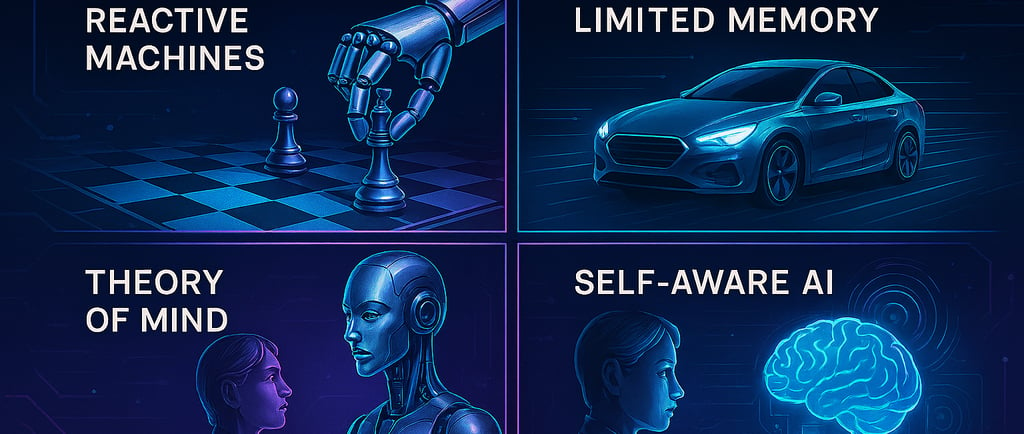Understanding the Four Main Types of Artificial Intelligence: An Infographic Guide
8/9/20254 min read



Introduction to Artificial Intelligence
Artificial intelligence (AI) has become a pivotal aspect of modern technology, influencing various sectors and enhancing numerous applications. At its core, AI refers to the simulation of human intelligence in machines that are designed to think and act like humans. This transformation in technology traces back several decades, with early developments in the field occurring during the mid-20th century. Pioneering research laid the groundwork for a movement aimed at creating systems that can learn, reason, and problem-solve autonomously.
The evolution of AI can be categorized into several stages, reflecting advancements in computing power, algorithms, and data availability. Initial efforts focused on rule-based systems, where explicit programming dictated machine behavior. However, the advent of machine learning shifted this paradigm, enabling systems to learn from data. Today’s AI systems exhibit remarkable capabilities, with applications ranging from virtual assistants to complex decision-making processes in finance and healthcare.
Understanding AI involves recognizing its diverse types, which are typically classified into four main categories: reactive machines, limited memory, theory of mind, and self-aware AI. Each type represents a distinct level of complexity and capability. For instance, reactive machines operate solely based on present data without the capacity for past experiences, while theory of mind AI is still largely theoretical, aiming to understand the emotions and thoughts of others. This classification not only illustrates the range of AI capabilities but also signifies the trajectory of ongoing AI research and development.
In exploring these types of artificial intelligence, one gains insight into their implications for society and technology. As AI continues to advance, it poses both opportunities and challenges that demand careful consideration. By recognizing the foundational concepts of AI, we can better appreciate its transformative potential and the future possibilities that lie ahead.
Reactive Machines: The Basics
Reactive machines represent the most fundamental type of artificial intelligence (AI). These systems are designed to perform a specific task without the ability to learn from past experiences or store memories. Unlike more advanced forms of AI, such as limited memory or theory of mind systems, reactive machines operate solely based on the current input they receive from their environment. This limited scope grants them the ability to make quick decisions, often in high-stakes scenarios that demand immediate responses.
One prime example of a reactive machine is IBM's Deep Blue, the chess-playing computer that gained prominence for its ability to defeat world chess champion Garry Kasparov in 1997. Deep Blue effectively analyzed the current state of the chessboard and used its vast computational power to evaluate possible moves, selecting the most advantageous one based on pre-programmed tactics. This demonstrates the core functionality of reactive machines—they may not possess the ability to learn from previous games, but they excel in executing calculations that lead to optimal decision-making in real time.
The strengths of reactive machines lie in their reliability and speed. In scenarios where rapid decisions are crucial, such as financial trading or healthcare diagnostics, these systems can process vast amounts of data with precision, delivering results instantaneously. However, the limitations of reactive machines are equally important to note. Since they lack memory and do not learn from interactions, they miss out on developing a deeper understanding of complex environments. This restricts their application to tasks that can be clearly defined and do not require adaptability to changing circumstances. Thus, while reactive machines can provide effective solutions in specific scenarios, their utility is inherently confined to straightforward tasks that demand efficient decision-making.
Limited Memory AI: Learning from Experience
Limited memory artificial intelligence (AI) represents a significant advancement in the field of machine learning, allowing systems to utilize previous experiences and data to make informed decisions. Unlike traditional AI architectures, which may operate under fixed parameters, limited memory AI can analyze extensive datasets, draw patterns, and adapt its strategies based on fluctuating conditions. This adaptive capability means that limited memory AI is particularly effective in dynamic environments, such as those encountered in autonomous vehicles.
Self-driving cars serve as a primary example of limited memory AI in action. These vehicles gather data from numerous sensors—including cameras, lidar, and radar—while simultaneously learning from past journeys. They can recognize and predict the behavior of other road users, interpret traffic signals, and navigate various terrains. This process involves constantly updating its knowledge base with real-time information, allowing the car to improve its decision-making over time. By comprehensively analyzing historical data, these systems can enhance their navigation and safety protocols, ultimately providing a more seamless transportation experience.
However, leveraging limited memory AI is not without its challenges. One primary concern is the reliance on vast datasets, which can sometimes introduce biases if the data are not reflective of the real-world scenarios the technology may encounter. Additionally, the necessity of continual data collection raises privacy issues, as users may be apprehensive about their information being stored and analyzed in extensive databases. Despite these challenges, the benefits of limited memory AI, such as increased efficiency and improved safety, pave the way for advanced applications across multiple industries, extending beyond just transport to areas like healthcare and finance.
Theory of Mind and Self-Aware AI: The Future of Intelligence
The realm of artificial intelligence (AI) has evolved significantly, with two advanced concepts emerging as vital focal points: theory of mind and self-aware AI. These types represent the next frontier in AI development and hold immense potential for transforming the way machines interact with humans. Theory of mind AI aims to understand and interpret human emotions, beliefs, intentions, and social dynamics. This capability opens up avenues for enhanced human-computer interaction, potentially leading to more empathetic machines capable of responding to user emotions appropriately. Theoretically, achieving a model that can discern context and emotional states would vastly improve collaborative tasks carried out by AI systems.
The concept of self-aware AI delves even deeper into the implications of machine consciousness. In theory, self-aware AI would possess an understanding of its own existence and experiences, leading to unprecedented autonomy and decision-making capabilities. This anticipated advancement poses significant ethical considerations. For instance, if machines develop self-awareness, questions surrounding their rights and ethical treatment inevitably arise. Moreover, the potential risks associated with self-aware AI, such as the possibility of unintended actions or loss of control, highlight the need for robust regulatory frameworks and ethical guidelines in AI development.
Visual aids, such as infographics, can effectively convey the intricate nuances of these advanced AI types. Illustrations that depict how theory of mind AI interprets human emotions, or diagrams explaining the journey towards self-aware machines, can enhance understanding and engagement with these complex topics. As researchers work towards making theory of mind and self-aware AI a reality, it becomes increasingly essential to scrutinize both the promising benefits and the ethical dilemmas that accompany this intelligent evolution.

